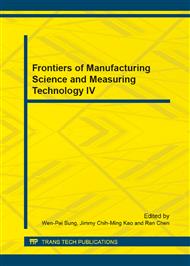p.136
p.140
p.144
p.148
p.153
p.160
p.164
p.169
p.179
The Friction and Wear Properties of Cu-Te-Li Alloys with High-Strength and High-Conductivity
Abstract:
The friction and wear properties of Cu-Te-Li alloys under dry sliding condition were studied by M-200 wear testing machine. The morphology and chemical composition of worn surfaces were analyzed by SEM and EDS, thus the effect of aging treatment on friction coefficient, wear rate and wear mechanism was discussed. The results showed that Te element could improve the wear resistance of copper alloys. With Te content increasing, the friction coefficient of Cu-Te-Li alloys declined slightly and tended to be stable as a whole, while the wear rate decreased obviously. During the process of dry sliding friction, adhesive wear was the dominant mechanism, with oxidative wear coexisting. But for the Cu-Te-Li alloys after aging treatment, abrasive wear appeared and adhesive wear was intensified, especially at higher friction velocity.
Info:
Periodical:
Pages:
153-159
Citation:
Online since:
August 2014
Authors:
Keywords:
Price:
Сopyright:
© 2014 Trans Tech Publications Ltd. All Rights Reserved
Share:
Citation:


